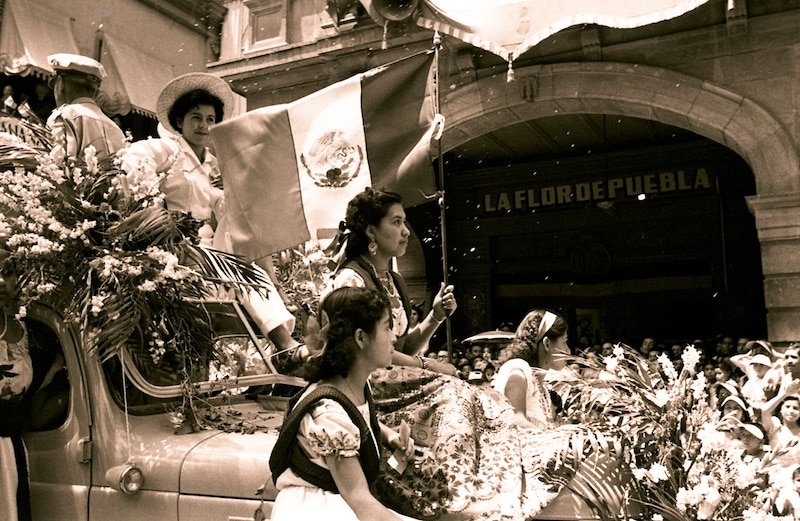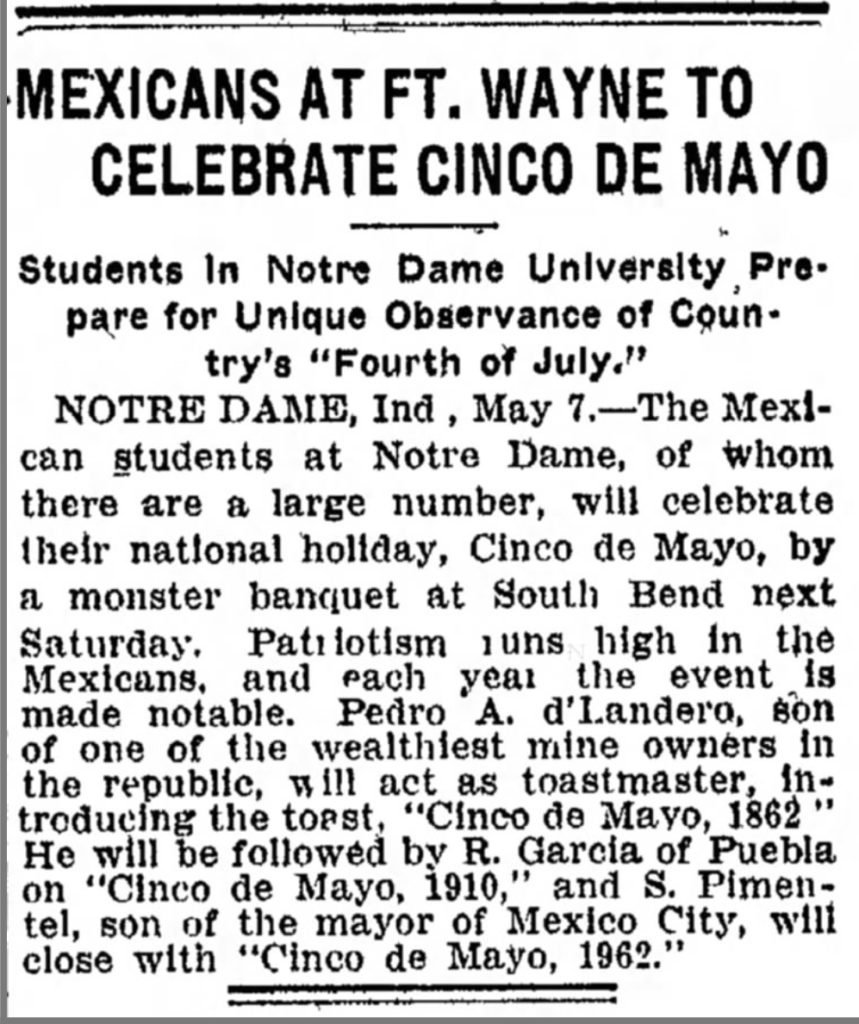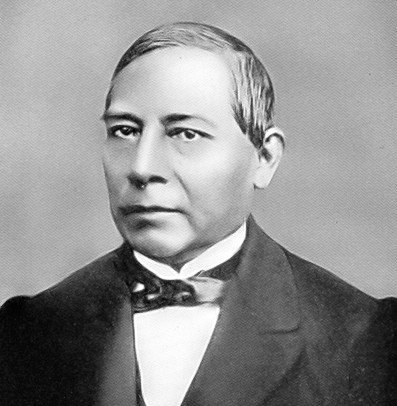
What Cinco de Mayo Can Teach Us About the Bible
How this holiday reminds us to hold fast to the truth
Please, before mentally preparing a rebuttal to the title, know that “What Cinco de Mayo Can Teach Us About the Bible” does not suggest that Cinco de Mayo can teach us the Bible, but only that it can illustrate something about how we approach the Word of God. But I digress. Well, what is Cinco de Mayo, anyway?

Figure 1. Town parade in Puebla, Mexico for Cinco de Mayo (El Día de la Batalla de Puebla) 1
Our experiences, such as television commercials, classroom decorations, and workplace conversations, can subtly legitimize what we already believe about this popular day.
Cinco de Mayo, Spanish for “May 5,” is not best understood by simply filling in the gaps in our understanding of a Mexican festivity with our culture’s party day mentality. If we do so, we may have difficulty obtaining an understanding that has any semblance to the historical event it represents. Our experiences, such as television commercials, classroom decorations, and workplace conversations, can subtly legitimize what we already believe about this popular day. In other words, if we begin with assumptions based on American culture about what Cinco de Mayo is, we may very well use them to interpret the true, historical event. Or at least, we may unwittingly look for a way to fit what we think we know into any reconstruction of the reason for the celebration. Therefore, I suggest it would be prudent to begin with a refutation of popular misconceptions about Cinco de Mayo before trying to grasp what it really is.
Cinco De Mayo Is Not Mexican Independence Day
The Mexican Revolution (for independence from Spain) began on September 16, 1810, and ended victoriously on September 27, 1821. Therefore, every year Mexico celebrates El Grito de Independencia (The Cry for Independence) on September 16. And it is a big deal there!
Cinco de Mayo, on the other hand, relates to an event that took place 52 years later. Although Spain was indirectly involved at first, the encounter was directly between France and Mexico. Admittedly, it is difficult to pinpoint the exact reason (or reasons) why so many have thought May 5 to be Mexico’s Independence Day; notwithstanding, this wrong assumption is not just a recent blooper, as seen in the Indianapolis Star article below.

Figure 2. Sunday, May 8, 1910, Indianapolis Star publishes article wherein Cinco de Mayo is equated with America’s 4th of July.2
Cinco De Mayo Is Not an Official Holiday/Day of Observance in Mexico
Although celebrated in some of the larger cities in Mexico (but nothing like other celebrated dates in the year), Cinco de Mayo is only recognized officially in Puebla, Mexico.3 In fact, it has not been referred to much by the phrase Cinco de Mayo, but historically more by “El Día de la Batalla de Puebla” (The Day of the Battle of Puebla). Only recently, mostly due to the internet and the influence of the US culture,4 more people in Mexico are starting to refer to this day as Cinco de Mayo.5
Cinco De Mayo Is “Probably” Not as Popular in Mexico as It Is in the US
I use the word probably because there is always room for an opposing opinion and it is difficult to quantify “popular.” I live in Mexico and have never observed much enthusiasm about the topic. I have never seen an open celebration on this date, and only now am I noticing how the government is promoting it more to foment national pride.
In contrast, the whole country shuts down and joins for celebration of Mexican Independence Day and even throughout the whole month leading up to September 16. But during my years living in the US, Cinco de Mayo was “celebrated” widely every year of my adult life.
On the political horizon in Mexico though, things are changing. The general indifference (relatively speaking) toward Cinco de Mayo may change soon, partially due to political reasons. Rallying people through passionate discourse on anti-imperialist propaganda would be helpful to the socialist cause. One of the ways this is accomplished is to incite greater patriotism to distance Mexico from US policy.6 If Mexico continues to embrace socialism, Cinco de Mayo may very well be brought into center stage in Mexico within the next few years as an example of how to deal with imperialism (US policy, influence, and even biblical Christianity are treated as imperialistic by many in Latin America who are fighting for leftist ideologies). That said, as of 2023, Cinco de Mayo is probably still recognized more in the United States than in Mexico, even though there is more confusion in the States about what it represents.
Once we abandon any faulty starting assumptions, we can begin from the correct foundation to better understand a historical event that took place in Mexico.
Early reasons for its popularity in the States are the Good Neighbor Policy of 1933 by President Franklin D. Roosevelt for establishing a better relationship with countries in the Americas and the Chicano activists in the 60s who emphasized Cinco de Mayo to promote pride in Americans of Latino descent. Then from the 80s until today, the festive day has been commercialized into what we now are familiar with—garden, pub, and street parties filled with gaudy costumes, Mexican food, and (sometimes) loud mariachi bands. If we want to know what Cinco de Mayo is historically all about though, we will have to shed the fake mustache and sombrero and take a step back.7
Once we abandon any faulty starting assumptions, we can begin from the correct foundation to better understand a historical event that took place in Mexico. Armed with knowledge of political history (Good Neighbor Policy, Chicano activists), we can better understand how the celebration bled into US culture and was commercialized to the popular, but faulty, image it has today.
What Cinco de Mayo Is
By way of analogy, consider the Civil War (1861–1865) in the US, which occurred almost a century after America’s independence from the British empire. But independence from without was not enough for peace within. A new country would now have to agree on political structure and rights (state vs. federal).8 Foundationally, something similar was happening simultaneously in Mexico. Although Mexico’s inner struggles were very different from the US, they were still political in nature. Mexico was free from Spain, but the politically conservative and the politically liberal factions were at sharp odds with each other.
Mexico in 1861, after decades of liberty from Spain, had recently come out of three years of Guerra de Reforma (Reform War), which was also a type of civil war. The politically conservative Conservadores, who had taken over Mexico City as their capital, sought the continuance of a sort of monarchal system very similar to medieval feudalism in Europe. On the other hand, the Liberales, whose capital was in Veracruz, fought for a democratic capitalist government.9 The United States stood by the Liberales and even sent its navy to defend them in Veracruz, but the British, Spanish, and French governments stood by the Conservadores and loaned money toward their efforts.
On December 22, 1860, the Conservadores surrendered, and on January 11, 1861, exactly three years after the war began, the liberal president Benito Juárez moved back to the capital in Mexico City. But, as with any war, an immediate happy ending was evasive. Mexico now had a debt to pay, and many groups did not want to submit to a united, free, and democratic system.
President Benito Juárez and the Mexican Congress, leading a nearly fractured, post-war nation, announced on July 17, 1861, that Mexico would suspend any payments for two years to the countries who supported the Conservadores: Great Britain, France, and Spain. These European powers responded quickly by signing the Convention of London10 on October 31, 1861, wherein the three nations would join in sending military force to collect.
Although troops from all three countries arrived at the coast of Mexico between December 1861 and January 1862, after negotiations with Mexican diplomats, only one would remain. Spain and Great Britain refrained from acting and left, but the French would not budge. In hindsight, some sources believe that Spanish and British diplomats left because they learned France was planning on taking over Mexico to extend its empire, and that was exactly what it did. Dubois de Saligny, French diplomat in Texas, was assigned to negotiate with the Mexican government on the debt repayment but decided to invade under the command of General Charles Ferdinand Latrille. On April 19, 1862, the French marched from Veracruz with a trajectory toward Mexico City for a takeover.
El Día de la Batalla De Puebla (Or Cinco De Mayo)
On May 4, 1862, the French arrived at Amozoc in the province of Puebla.11 And on May 5, an ill-prepared and under-resourced Mexican army was able to defeat them in Puebla, Mexico. Although the battle of Puebla was lost, the French persisted and marched into Mexico City where they took over and established what is referred to as the “Second Empire.” Mexico was, again, under a European empire.

Figure 3. Maximilian of Habsburg, Archduke of Austria, Emperor of Mexico12
Emperor Napoleon III of France named Maximilian, his relative and the Archduke of Austria, to be the new emperor of Mexico. The US issued statements of disapproval but was embroiled in her own Civil War and did not want to get militarily involved or provoke France into supporting the Confederates. However, US General Ulysses S. Grant and Philip Henry Sheridan began covert support of Juárez against the French imperialist regime. Emperor Maximilian’s success would be short-lived. After losing the support of the Conservadores, who originally embraced his arrival, and dealing with the constant unrest by the Liberales with unofficial US support, the French treasury was bleeding out. So on January 31, 1866, Napoleon III ordered a three-stage plan to withdraw French troops from Mexico. Maximilian, though, refused to leave his lost empire. Mexican President Benito Juárez returned to power, and Maximilian was consequently executed.

Figure 4. Benito Juárez, Mexican President (1858–1872)13
The battle in Puebla stands forever as a national reminder of the need for resolve and strength when outnumbered and outgunned.
In short, El Día de la Batalla de Puebla (May 5) is a nationally unofficial holiday where Mexican citizens remember the battle where they were disadvantaged and outmanned—some figures estimate by three to two and others two to one. Although the French troops did continue after their defeat to take over Mexico City, the battle in Puebla stands forever as a national reminder of the need for resolve and strength when outnumbered and outgunned. Those soldiers on May 5, being diligent, brave, and strong in battle, remind us of the Apostle Paul’s instruction to the church to be watchful, brave, and strong in the faith of our Lord (1 Corinthians 16:13).
But What About Cinco De Mayo and the Bible?
Returning to our title, many among us today were born into a culture that was (and in some ways continues to be) influenced by the gospel. Sadly though, the culture’s lack of understanding or acknowledgement of the history, sufficiency, and authority of Scripture has resulted in the use of Christian terms, ethical structures, and vestiges of biblical mandates with no idea about the source or how far from Scripture they have become.
Therefore, when many in our culture hear or read in Scripture something that does not jibe with postmodern “tolerance,” they either reject the faith outright or dismiss the authoritative and exclusive nature of Scripture by suggesting and imposing other ideologies or mysticism throughout. We are witnessing, relatively speaking, a consensus wherein the Bible is considered only helpful and good as long as it assists a person’s quest and drive for purpose on their terms. The God who created everything in six days and who judges sin (e.g., with a global flood) is just not what people lost in sin want.
But only the God of Scripture saves.
But only the God of Scripture saves. Only the one true God shows grace and sent his Son to find us, pay the penalty of our treachery, and bring us to him. Our duty, as Christians, is to tell the world the truth of Scripture, from cover to cover. If our world is shocked that God’s Word sounds nothing like what they have been celebrating throughout their life, they will either repent or reject it (even if they modify it to their likeness, that is still rejecting God’s Word).
But we, on the other hand, must insist on standing firm on the truth of God’s Word because the Bible exegetes (makes known) Jesus, and only through him can our spiritual blindness be healed to see the revealed glory of God. The gospel needs no “Good Neighbor” policy, activists, or commercialization to retain relevance. The gospel has been, is, and will always be relevant.
On this Cinco de Mayo, people across the US will celebrate. Most will probably not be celebrating the victory in Puebla for the Mexican troops. Some may live their lives, year after year, thinking that they celebrate Mexican Independence Day, but ultimately, such ignorance of that historical truth is of no eternal consequence. I have no conviction to preach the historicity of a real event in nineteenth-century Mexico.
But we should be concerned that many today may be celebrating something else that has been twisted by cultural tradition. We should fear that many may unwittingly identify as “church goers” or “Christians” but have a socially formed understanding that is not founded on the Bible. We should be aware that many are hoping in a personified amalgamation of postmodernism, post-truth, and existentialist humanism. We should tremble to think that some wrongly know and call on the name of “Jesus” but would not recognize the true, glorious King Jesus who became flesh 2000 years ago. They need to know the eternal and majestic Jesus, God the Son, through whom God the Father created the world—the one who sustains the world and came to die in the place of many (Hebrews 1:1–3)! We should fear that many, on that final day, will only know Jesus as Judge and Lord of all and not as Savior and their loving Lord (Acts 17:31; Philippians 2:9–11).
Such fear should not be fatalistic or paralyzing (2 Timothy 1:7) but rather a healthy preoccupation for the wellbeing of our neighbor. We must respond to those caught up in the festivities of life (Matthew 24:37–39) with no regard to what and who is the fount of joy and life. The world is laughing but unaware of any truly good reason to rejoice. And we must not consider ourselves any better, as it is only by God’s grace that we know Christ and have something real to celebrate. Those of us who were raised hearing of Jesus, whether by family or society, initially had an idea of Jesus based on a dead, sinful heart. But those who have had the Holy Spirit work in their hearts now truly know him and are known by him. One of the ways that we celebrate is to share the wonderful truth of Christ. Let us share Christ to those blindly celebrating that which they do not know.
Footnotes
- Photo courtesy of Mexico National Government, https://www.gob.mx/agn/articulos/agnrecuerda-el-5-de-mayo-la-batalla-de-puebla, accessed May 2, 2023.
- Nicole Martinez-LeGrand, “The Real History Behind Cinco de Mayo,” Indiana History, accessed May 2, 2023, https://indianahistory.org/blog/the-real-history-behind-cinco-de-mayo/.
- Gobierno de México (Mexican Government) list of national days of observance, “¿Sabes cuáles son los días de Descanso Obligatorios?” accessed May 2, 2023, https://www.gob.mx/profedet/es/articulos/sabes-cuales-son-los-dias-de-descanso-obligatorios-163134?idiom=es.
- US culture has more recently had much impact on Mexican culture. Today, in most cities in Mexico, children and young adults celebrate Halloween on October 31 and then El Día de los Muertos (The Day of the Dead) on November 1–2. This is a recent phenomenon as learned from movies and streaming platforms from the US that are popular in Mexico.
- Even on the official state government webpage for Puebla, where May 5 is an official day of observance, May 5 is only written down to give the date of an activity, but the activity itself is referred to as “The Day of the Battle of Puebla” (https://www.puebla.gob.mx/index.php/noticias/item/12173-confirma-sergio-salomon-asistencia-de-amlo-al-desfile-del-5-de-mayo).
- Although the US is becoming more leftist, there continues to exist a great ideological gap between Mexico’s leftist posture and that of the US.
- I am not suggesting that wearing a sombrero is “cultural appropriation” and wrong. I cannot speak for everybody, but I have never met a Mexican who is offended by that. The politicized environment in the US today of Critical Theory (coined first in 1930 at the Frankfurt School in Germany for the intentional spreading of Social Marxism) has not had the same effect in Mexico yet. At least where I live and serve in Mexico, you can still be lighthearted without always worrying who you could offend. If you show a humble and kind attitude, most people will have a good laugh at gringo antics.
- Among other issues, such as slavery of course.
- We must refrain from anachronistic comparisons with the sociopolitical ideals between conservatives and liberals in the twenty-first century. The word “conservative” refers to conservation or to preserve. So, the Conservadores in Mexico wanted to preserve the elitist system of Spain and for government to have greater control in protecting only the rights of the elite, and the Liberales wanted freedom for all to have opportunities in a free market. The mindset involved was more about monarchy and a type of feudalism vs. free democracy.
- “French Intervention in Mexico and the American Civil War, 1862–1867,” Office of the Historian, accessed May 2, 2023, https://history.state.gov/milestones/1861-1865/french-intervention.
- Secretaría de la Defensa Nacional, “La Intervención Francesa,” Gobierno de México, published July 16, 2015, accessed May 2, 2023, https://www.gob.mx/sedena/documentos/la-intervencion-francesa.
- “French Intervention in Mexico.”
- “French Intervention in Mexico.”
Recommended Resources

Answers in Genesis is an apologetics ministry, dedicated to helping Christians defend their faith and proclaim the good news of Jesus Christ.
- Customer Service 800.778.3390
- Available Monday–Friday | 9 AM–5 PM ET
- © 2026 Answers in Genesis





